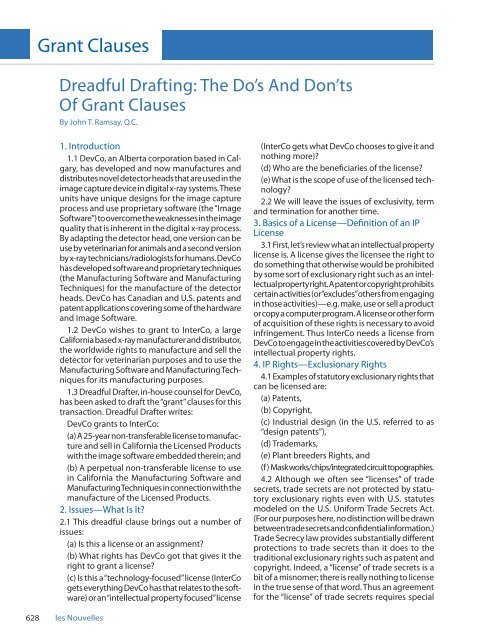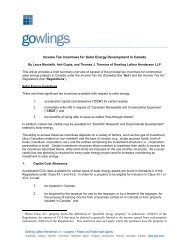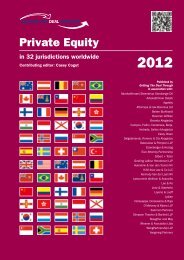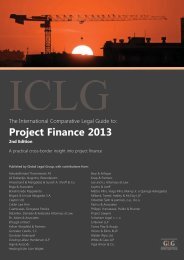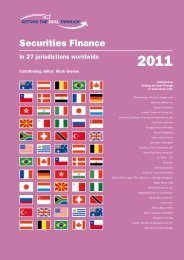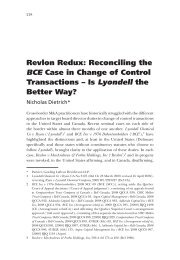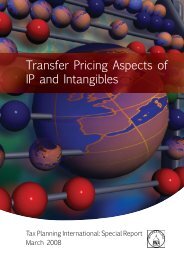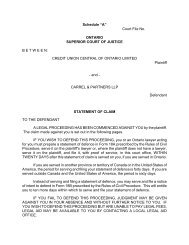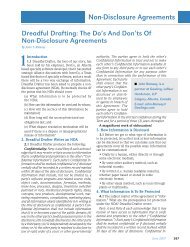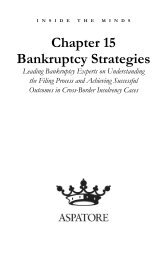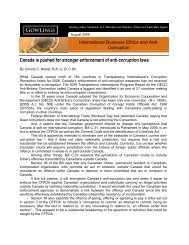Dreadful Drafting: The Do's and Don'ts of Grant Clauses - Gowlings
Dreadful Drafting: The Do's and Don'ts of Grant Clauses - Gowlings
Dreadful Drafting: The Do's and Don'ts of Grant Clauses - Gowlings
- No tags were found...
You also want an ePaper? Increase the reach of your titles
YUMPU automatically turns print PDFs into web optimized ePapers that Google loves.
<strong>Grant</strong> <strong>Clauses</strong><strong>Dreadful</strong> <strong>Drafting</strong>: <strong>The</strong> Do’s And Don’tsOf <strong>Grant</strong> <strong>Clauses</strong>By John T. Ramsay, Q.C.1. Introduction1.1 DevCo, an Alberta corporation based in Calgary,has developed <strong>and</strong> now manufactures <strong>and</strong>distributes novel detector heads that are used in theimage capture device in digital x-ray systems. <strong>The</strong>seunits have unique designs for the image captureprocess <strong>and</strong> use proprietary s<strong>of</strong>tware (the “ImageS<strong>of</strong>tware”) to overcome the weaknesses in the imagequality that is inherent in the digital x-ray process.By adapting the detector head, one version can beuse by veterinarian for animals <strong>and</strong> a second versionby x-ray technicians/radiologists for humans. DevCohas developed s<strong>of</strong>tware <strong>and</strong> proprietary techniques(the Manufacturing S<strong>of</strong>tware <strong>and</strong> ManufacturingTechniques) for the manufacture <strong>of</strong> the detectorheads. DevCo has Canadian <strong>and</strong> U.S. patents <strong>and</strong>patent applications covering some <strong>of</strong> the hardware<strong>and</strong> Image S<strong>of</strong>tware.1.2 DevCo wishes to grant to InterCo, a largeCalifornia based x-ray manufacturer <strong>and</strong> distributor,the worldwide rights to manufacture <strong>and</strong> sell thedetector for veterinarian purposes <strong>and</strong> to use theManufacturing S<strong>of</strong>tware <strong>and</strong> Manufacturing Techniquesfor its manufacturing purposes.1.3 <strong>Dreadful</strong> Drafter, in-house counsel for DevCo,has been asked to draft the “grant” clauses for thistransaction. <strong>Dreadful</strong> Drafter writes:DevCo grants to InterCo:(a) A 25-year non-transferable license to manufacture<strong>and</strong> sell in California the Licensed Productswith the image s<strong>of</strong>tware embedded therein; <strong>and</strong>(b) A perpetual non-transferable license to usein California the Manufacturing S<strong>of</strong>tware <strong>and</strong>Manufacturing Techniques in connection with themanufacture <strong>of</strong> the Licensed Products.2. Issues—What Is It?2.1 This dreadful clause brings out a number <strong>of</strong>issues:(a) Is this a license or an assignment?(b) What rights has DevCo got that gives it theright to grant a license?(c) Is this a “technology-focused” license (InterCogets everything DevCo has that relates to the s<strong>of</strong>tware)or an “intellectual property focused” license(InterCo gets what DevCo chooses to give it <strong>and</strong>nothing more)?(d) Who are the beneficiaries <strong>of</strong> the license?(e) What is the scope <strong>of</strong> use <strong>of</strong> the licensed technology?2.2 We will leave the issues <strong>of</strong> exclusivity, term<strong>and</strong> termination for another time.3. Basics <strong>of</strong> a License—Definition <strong>of</strong> an IPLicense3.1 First, let’s review what an intellectual propertylicense is. A license gives the licensee the right todo something that otherwise would be prohibitedby some sort <strong>of</strong> exclusionary right such as an intellectualproperty right. A patent or copyright prohibitscertain activities (or “excludes” others from engagingin those activities)—e.g. make, use or sell a productor copy a computer program. A license or other form<strong>of</strong> acquisition <strong>of</strong> these rights is necessary to avoidinfringement. Thus InterCo needs a license fromDevCo to engage in the activities covered by DevCo’sintellectual property rights.4. IP Rights—Exclusionary Rights4.1 Examples <strong>of</strong> statutory exclusionary rights thatcan be licensed are:(a) Patents,(b) Copyright,(c) Industrial design (in the U.S. referred to as“design patents”),(d) Trademarks,(e) Plant breeders Rights, <strong>and</strong>(f ) Mask works/chips/integrated circuit topographies.4.2 Although we <strong>of</strong>ten see “licenses” <strong>of</strong> tradesecrets, trade secrets are not protected by statutoryexclusionary rights even with U.S. statutesmodeled on the U.S. Uniform Trade Secrets Act.(For our purposes here, no distinction will be drawnbetween trade secrets <strong>and</strong> confidential information.)Trade Secrecy law provides substantially differentprotections to trade secrets than it does to thetraditional exclusionary rights such as patent <strong>and</strong>copyright. Indeed, a “license” <strong>of</strong> trade secrets is abit <strong>of</strong> a misnomer; there is really nothing to licensein the true sense <strong>of</strong> that word. Thus an agreementfor the “license” <strong>of</strong> trade secrets requires special628les Nouvelles
<strong>Grant</strong> <strong>Clauses</strong>language to cover the right to gain access to <strong>and</strong>use the “licensed” secret in exchange for the duty<strong>of</strong> restricted use (<strong>and</strong> no other use or “misuse” or“misappropriation”) <strong>and</strong> continued secrecy <strong>of</strong> thatsecret (i.e. a prohibition against disclosure exceptunder clearly specified circumstances).4.3 Thus the IP rights that DevCo has available tolicense are:(a) <strong>The</strong> issued patents;(b) <strong>The</strong> right to license the patents that will resultfrom the patent applications;(c) <strong>The</strong> copyright in the image s<strong>of</strong>tware, theManufacturing S<strong>of</strong>tware <strong>and</strong> any codification (e.g.manuals) <strong>of</strong> the Manufacturing Techniques;(d) Trade secrets in the Image S<strong>of</strong>tware, ManufacturingS<strong>of</strong>tware <strong>and</strong> the Manufacturing Techniques.5. Assignment <strong>of</strong> License—Less Than All5.1 A license is the grant <strong>of</strong> permission to do anactivity that otherwise would be prohibited by someexclusionary IP right possessed by the licensor. Alicense is a transfer <strong>of</strong> part <strong>of</strong> those rights whereasan assignment is a transfer <strong>of</strong> all <strong>of</strong> the IP rights.A license is not an assignment <strong>of</strong> the underlyingexclusionary intellectual property right; it is a grant<strong>of</strong> something less than all those rights.5.2 An exclusive license may look like an assignment;the difference may be hard to determinein some cases since the economic effects are sosimilar.5.3 Each <strong>of</strong> an exclusive license <strong>and</strong> an assignmentmay get capital gains treatment in the U.S.;Canada’s treatment is more complex, depending onthe taxpayer’s practice <strong>of</strong> granting licenses—theylook to see if there is some sort <strong>of</strong> business <strong>of</strong> grantinglicenses.5.4 An assignor may be an unsecured creditor <strong>and</strong>rank behind secured creditors. Thus the assignormay run the risk that secured creditors gain thebenefit <strong>of</strong> the value <strong>of</strong> the intellectual property rightstransferred by the assignor. A licensor, on the otherh<strong>and</strong>, may be able to terminate the license <strong>and</strong> thusget the intellectual property rights back.5.5 Some phrases that indicate a license ratherthan an assignment are:(a) “Subject to the terms <strong>of</strong> this Agreement”(b) “No rights are granted to the Licensee otherthan those expressly granted by this Agreement”(c) “Such licensed rights continuing as long as”(d) “Such licensed rights terminable upon”5.6 More confusing phrases are:(a)“Irrevocable.” If you use this word it is recommendedthat you make it clear in the same or ajuxtaposed sentence that the license is subject totermination as specified in the termination clause.Better yet, use the word “irrevocable” only for assignments.Some judge may want to find an assignment<strong>and</strong> use that word as an excuse to justify anotherwise weak legal conclusion (using the “smelltest” model for jurisprudence: decide first <strong>and</strong> thenfind the law to support the conclusion later).(b) “Perpetual.” Ins<strong>of</strong>tware licenses, thishas the street connotation<strong>of</strong> a “fully Gowling Lafleur Henderson■ John T. Ramsay, Q.C. <strong>of</strong>paid up” license. Itsuse may be risky in aLLP Barristers & Solicitors,legal document since Calgary, Canada.it could be interpreted E-mail: john.ramsay@as an assignment—thepremise might be thatgowlings.comif nothing is left afterperpetuity it has to be an assignment.6. Exclusionary Patent Rights—ControlledActivities6.1 Let us first look at the rights granted by patents,perhaps the most critical, complex <strong>and</strong> valuabletype <strong>of</strong> intellectual property:(a) Section 42 Canadian Patent Act states that apatent gives the holder the “exclusive right, privilege<strong>and</strong> liberty <strong>of</strong>(i) making, constructing <strong>and</strong> using the invention;<strong>and</strong>(ii) selling it to others to be used.”(b) Similarly the U.S. Patent Act, in s.271 providesthat anyone who does the following infringes therights <strong>of</strong> the patent holder (a “patentee”):(i) Makes, uses, <strong>of</strong>fers to sell, or sells any patentedinvention, within the United States orimports into the United States any patentedinvention.(ii) Imports into the United States or <strong>of</strong>fers tosell, sells, or uses within the United States aproduct which is made by a process patented inthe United States.6.2 As a result <strong>of</strong> these exclusionary statutorypatent rights, generally the activities licensed underpatents could include the right to:(a) “Make, use, <strong>of</strong>fer to sell, sell <strong>and</strong> import LicensedProducts;”(b) “Make, use, <strong>of</strong>fer to sell, sell <strong>and</strong> import Li-December 2007629
<strong>Grant</strong> <strong>Clauses</strong>censed Products that are covered by the LicensedPatents;”(c) “Make, use, <strong>of</strong>fer to sell, sell <strong>and</strong> import into[Canada/United States] Licensed Products that arecovered by the Licensed Patents <strong>and</strong> that are withinthe Field <strong>of</strong> Use;”(d) “Make, use, <strong>of</strong>fer to sell, sell <strong>and</strong> import into[Canada/United States] Licensed Compositions.”Like Licensed Products, the Licensed Compositionscould be all compositions that are covered by theLicensed Patents or be more restricted <strong>and</strong> be onlythose that are both covered by the Licensed Patents<strong>and</strong> are within the Field <strong>of</strong> Use;(e) “Practise the Licensed Processes.” Again, theLicensed Processes could be all processes thatare covered by the Licensed Patents or only thoseprocesses that are both covered by the LicensedPatents <strong>and</strong> are within the Field <strong>of</strong> Use;(f) “Make use, <strong>of</strong>fer to sell, sell <strong>and</strong> import [Canada/United States] products produced by the practice<strong>of</strong> the Licensed Processes;”(g) “Make, use, <strong>of</strong>fer to sell, sell <strong>and</strong> import machinesthat will enable the Licensed Process;”(h) “Make only.” It might be prudent but cautiouspractice to specify that “make” does not includethe right to sell. Consider whether:(i) the Licensee can “use” for its own internalpurposes;(ii) the Licensee can make only for the Licensor<strong>and</strong> no one else;(i) “Have made.” Many drafters want to make surethe “have made” only benefits the Licensee <strong>and</strong>thus use the phrase “have made only for the Licensor.”When drafting a “have made” clause, <strong>Dreadful</strong>Drafter could consider combined licenses <strong>of</strong> tradesecrets <strong>and</strong> patents. How does Licensor control <strong>and</strong>enforce secrecy <strong>and</strong> restricted use against the contractor?<strong>The</strong> Licensor has no privity <strong>of</strong> contract withthe contractor <strong>and</strong> thus may need a non-disclosureagreement directly with the contractor.(j) “Import into [Canada/the United States];(k) “Export.” <strong>The</strong> right to export may be excluded ifyour grant clause was restricted to activities in theU.S. or Canada. Often such a territorial restrictionis inserted into the grant clause due to concernsover anti-trust rules that prohibit licenses that purportto grant rights that do not exist; for examplegranting worldwide rights where there is only aU.S. patent, or otherwise granting overreachinglicenses. If those ant-trust rules do not apply, considerwhether the right to export is appropriate.DevCo has no Licensed Compositions <strong>and</strong> thereforethat does not apply here. Even though DevCo has notapplied for patent protection for its ManufacturingS<strong>of</strong>tware or Manufacturing Techniques, there maystill be trade secrets involved. Thus, there could bea license <strong>of</strong> these “processes.” <strong>Dreadful</strong> Drafter has,rather sloppily perhaps, picked these up in the licenseto use the Manufacturing S<strong>of</strong>tware <strong>and</strong> ManufacturingTechniques in connection with the manufacture<strong>of</strong> the Licensed Products.6.3 For an activity to be truly “licensed,” it mustbe covered by a claim in one or more <strong>of</strong> the LicensedPatents. For example under patents, a patent license“overreaches” if the definition <strong>of</strong> “Licensed Products”is not limited to those covered by the LicensedPatents. To avoid overreaching, consider defining“Licensed Products” to mean:Any product or process that uses or embodies anyinvention claimed in one or more <strong>of</strong> the claims <strong>of</strong> theLicensed Patents.7. <strong>The</strong> <strong>Grant</strong>: Technology Specific <strong>Grant</strong>svs Intellectual Property Specific <strong>Grant</strong>s7.1 Fundamentally there are two types <strong>of</strong> grant:(a) one type focuses on the technology or the applications<strong>of</strong> the intellectual property, <strong>and</strong>(b) the other type focuses on the intellectual propertyitself.<strong>Dreadful</strong> Drafter’s wrote for his grant clause DevCohereby grants to InterCo <strong>and</strong> its affiliates a perpetualnon-transferable sole <strong>and</strong> exclusive 25 year license touse in California the s<strong>of</strong>tware described in Schedule A.He refers to the “S<strong>of</strong>tware,” obviously a technologyfocusrather than a focus on the precise intellectualproperty rights. Thus, we can expect that he wantedto cover all intellectual property that related to theS<strong>of</strong>tware: the Licensee was to get a license <strong>of</strong> any<strong>and</strong> all intellectual property that was needed to use<strong>and</strong> otherwise gain the benefits <strong>of</strong> the S<strong>of</strong>tware.<strong>Dreadful</strong> Drafter did not care what specific patentsor other intellectual property rights were embodiedin the S<strong>of</strong>tware—he wanted them all.7.2 S<strong>of</strong>tware licenses are somewhat unique; they<strong>of</strong>ten do not refer to the intellectual property rightsthat give rise to the right to license. <strong>The</strong> premise isthat all intellectual property rights that are under thecontrol <strong>of</strong> the Licensor are to be licensed. Despitethis common practice, it would be better practice tospecify any existing <strong>and</strong> pending patent rights, anyother registered rights <strong>and</strong> then refer generally to allunregistered rights such as unregistered copyright aswell as other rights that could cover the S<strong>of</strong>tware.630les Nouvelles
<strong>Grant</strong> <strong>Clauses</strong>8. Comprehensive Subject Matter: AllIntellectual Property Rights8.1 Perhaps <strong>Dreadful</strong> Drafter wants to cover allpatents <strong>and</strong> patent applications that apply to a particularactivity rather than focused on one patent orfamily <strong>of</strong> patents. Consider:(a) Under all patents owned/controlled by the Licensor,<strong>and</strong> subject to the terms <strong>and</strong> conditions <strong>of</strong>this Agreement, the Licensor hereby grants to theLicensee a license to engage in any activity that,absent a license, would infringe or misappropriatea patent owned/controlled by the Licensor.(b) “Licensable Activities” means any activity absenta license would infringe or misappropriate a patentor Intellectual Property Right owned/controlled bythe Licensor.9. Specific Patents Only9.1 For grants that are focused on specific patentsrather than all the patents <strong>and</strong> other intellectualproperty that might apply, consider:(a) “Licensed Patent” means one <strong>of</strong> the followingpatents [insert list or other details];(b) “Licensed Product” means any apparatus orcomposition encompassed within the scope <strong>of</strong> aclaim in a Licensed Patent <strong>and</strong> shall also includea product that was manufactured, at least in part,by a process encompassed within the scope <strong>of</strong> aclaim in a Licensed Patent.10. Patent Applications10.1 Patent Applications cannot be truly licenseduntil they result in issued patents. However, thelicensee will want to have the license immediatelyupon issue without more <strong>and</strong> will want to have protectionagainst the issuance having retroactive effectfrom the date <strong>of</strong> issue back to the date <strong>of</strong> publication.Consider what happens if(a) <strong>The</strong> patent application does not issue;(b) <strong>The</strong> patent application does not issue within astated time period;(c) <strong>The</strong> patent application issues but not with theclaims that were critical to the licensee;(d) <strong>The</strong> patent application issues in one country(say, Canada) but not in another important country(say, the United States); <strong>and</strong>(e) <strong>The</strong> claims that issue are different from onecountry to another.10.2 If Patent Applications are involved, <strong>Dreadful</strong>Drafter will want to cover all the derivatives <strong>of</strong> apatent application. Consider:Patent Applications means any <strong>of</strong> the followingpatent applications, all divisions <strong>and</strong> continuations<strong>of</strong> such patent applications <strong>and</strong> all patents issuingfrom such applications, all divisions, continuations,continuations-in-part, <strong>and</strong> all reissues, renewals,reexamination certificates <strong>and</strong> extension <strong>of</strong> suchpatents.10.3 If there is concern that a derivative <strong>of</strong> apatent application could have claims not includedin the application that is the subject <strong>of</strong> the license,consider:“Licensed Patent Rights” shall mean:a) U.S. patent applications <strong>and</strong> patents listed inAppendix A, all divisions <strong>and</strong> continuations <strong>of</strong>these applications, all patents issuing from suchapplications, divisions, <strong>and</strong> continuations, <strong>and</strong> anyreissues, reexaminations, <strong>and</strong> extensions <strong>of</strong> all suchpatents;b) to the extent that the following contain one ormore claims directed to the invention or Inventionsclaimed in a) above:i) continuations-in-part <strong>of</strong> a) above;ii) all divisions <strong>and</strong> continuations <strong>of</strong> these continuations-in-part;iii) all patents issuing from such continuations-inpart,divisions, <strong>and</strong> continuations; <strong>and</strong>iv) any reissues, reexaminations, <strong>and</strong> extensions<strong>of</strong> all such patents;c) to the extent that the following contain one ormore claims directed to the invention or inventionsclaimed in a) above: all counterpart foreign applications<strong>and</strong> patents to a) <strong>and</strong> b) above, including thoselisted in Appendix A.Licensed Patent Rights shall not include b) or c)above to the extent that they contain one or moreclaims directed to new matter which is not thesubject matter <strong>of</strong> a claim in a) above.11. Just Valid Claims11.1 Instead <strong>of</strong> referring to specific patents <strong>and</strong>thus all the claims in those patents, <strong>Dreadful</strong> Draftercould refer to “Valid Claims.” This narrow grantclause could be chosen to:(a) Avoid paying royalties for activities covered byinvalid claims (in Canada the patent abuse rulesthat prohibit the requirement to pay royalties wheninvalidity has been determined are not as clear asthey are in the U.S.—it is better to address theissue in the contract);(b) To reduce the risk <strong>of</strong> violating patent abuse oranti-trust/anti-competitive rules;(c) To keep the scope <strong>of</strong> a license granted as a resultDecember 2007631
<strong>Grant</strong> <strong>Clauses</strong><strong>of</strong> a settlement <strong>of</strong> litigation to a minimum.11.2 Delphion defines a valid patent as “A validpatent is an issued patent that is not invalid for one<strong>of</strong> several reasons, the most common <strong>of</strong> which is thatone or more <strong>of</strong> its claims read on prior art that was notconsidered by the patent <strong>of</strong>fice during patent prosecution.While only a court can hold a patent is invalid,many patents are informally referred to as being invalidto indicate that a court would likely rule them so.”11.3 Delphion also defines a valid claim as “onewhich reads on the invention described in thespecification but does not read on any prior art.”Consider:(a) “Valid Claim” means a patent claim in a LicensedPatent that:(i) Has not expired, where the claim has notbeen disclaimed or cancelled from the LicensedPatent.(ii) Has not been held invalid by the final decision<strong>of</strong> a court <strong>of</strong> competent jurisdiction from whichno appeal is or can be taken;(iii) Has not been held by the final decision <strong>of</strong> acourt <strong>of</strong> competent jurisdiction from which noappeal is or can be taken to prohibit the LicensedActivities.(iv) If a claim has been held to be invalid by thefinal decision <strong>of</strong> a court <strong>of</strong> competent jurisdictionfrom which no appeal is or can be taken, then,for the purposes <strong>of</strong> this definition <strong>and</strong> this Agreement,effective as <strong>of</strong> the date <strong>of</strong> such final decision,such claim will be deemed to be deleted from thescope <strong>of</strong> this definition <strong>of</strong> “Valid Claim” <strong>and</strong> thusthis License <strong>and</strong> such claim will be deemed to belimited in scope to delete from this definition <strong>of</strong>“Valid Claim” the portion that was held to be notinfringed.12. All Necessary Patents or Claims12.1 When the Licensor <strong>and</strong> Licensee are competitors,they may want to narrow the subject matter<strong>of</strong> the license to the absolute minimum.12.2 “Necessary Claims” or “Essential Claims”are phrases used in patent pools or for licenses <strong>of</strong>industry st<strong>and</strong>ard technology. For example, the 3GSt<strong>and</strong>ard License Agreement defines an “EssentialPatent” as “any patent claiming an apparatus, combination,method or process necessary for compliancewith the 3G St<strong>and</strong>ard under the laws <strong>of</strong> the countrywhich issued or published the patent.” Consider also:“Essential patents are those patents, including patentapplications, whose infringement is unavoidable ina compliant implementation <strong>of</strong> either m<strong>and</strong>atory oroptional portions <strong>of</strong> a st<strong>and</strong>ard <strong>and</strong> where there isno other reasonable technical implementation available.”12.3 Rather than referring to patents, a cautiousdrafter may want to restrict the scope to claims. Forexample, Micros<strong>of</strong>t grants licenses to encourageadoption <strong>and</strong> use <strong>of</strong> its XML Paper Specifications:Micros<strong>of</strong>t hereby grants you a royalty-free licenseunder Micros<strong>of</strong>t’s Necessary Claims to make, use,sell, <strong>of</strong>fer to sell, import, <strong>and</strong> otherwise distributeLicensed Implementations solely for the purpose<strong>of</strong> reading or writing XPS Documents, or renderingXPS Documents as allowed by the XML PaperSpecification.12.4 <strong>The</strong> key phrase here is the definition <strong>of</strong>“Necessary Claims”:<strong>The</strong> term “Necessary Claims” means claims <strong>of</strong> a patentor patent application (including continuations,continuations-in-part, or reissues) that are ownedor controlled by Micros<strong>of</strong>t <strong>and</strong> that are necessarilyinfringed by the Licensed Implementation. A claimis necessarily infringed only when it is not possibleto avoid infringing when reading or writing XPSDocuments, or rendering XPS Documents as allowedby the XML Paper Specification.12.5 To ensure that the license for the purpose <strong>of</strong>the st<strong>and</strong>ard does not require the licensor (or thecontributor <strong>of</strong> the patent to the patent pool) to paya royalty to a third party for patents that the licensorcontrols but does not own, Micros<strong>of</strong>t removed themfrom the definition <strong>of</strong> Necessary Claims by addingNotwithst<strong>and</strong>ing the foregoing, “Necessary Claims”do not include any claims: (i) that would require apayment <strong>of</strong> royalties by Micros<strong>of</strong>t to unaffiliated thirdparties….13. Core Patents/Claims13.1 <strong>The</strong> Licensee will want to make sure that ithas the right to terminate the license if the claimsthat are essential or core to its needs are held tobe invalid or if the patent expires. In the U.S., theLicensor cannot dem<strong>and</strong> royalties if the licensedpatent is held to be invalid or otherwise expires, butthat is not the law in Canada. Even in the U.S., theLicensee will have to continue to pay if the patentitself is still valid but the claim that is core to theLicensee’s needs is held to be invalid.14. Times Specific <strong>Grant</strong>s14.1 When <strong>Dreadful</strong> Drafter granted the right to“use” the S<strong>of</strong>tware, was he granting a right to exercise632les Nouvelles
<strong>Grant</strong> <strong>Clauses</strong>only those Intellectual Property Rights that DevCo hadat the time <strong>of</strong> the grant or was he granting a license<strong>of</strong> rights that arise thereafter—such as patents thatsubsequently issue or copyrighted code subsequentlycreated? He needs to specifically address whetherthe grant include rights created, issued, or otherwiseobtained after the Effective Date.14.2 <strong>The</strong>re are times that the Licensee wants toget a license <strong>of</strong> all patent claims that arise out <strong>of</strong>patents issued by a certain date as well as patentsthat arise out <strong>of</strong> applications filed by that same date.Any filed after that date will not be included in thelicense. Consider:Licensor grants Licensee a license under the PatentRights <strong>and</strong> under all patent claims owned oracquired by Licensee, <strong>and</strong> having an effective filingdate before September 15, 2010, to make, use,sell, <strong>and</strong> import Licensed Products <strong>and</strong> to practiseLicensed Processes in the Field <strong>of</strong> Use, subject tothe terms <strong>and</strong> conditions <strong>of</strong> this Agreement.15. Multiple Patents in Package—Anti-Trust15.1 “Packaging” multiple intellectual propertyrights whether they are multiple patents or acombination <strong>of</strong> various intellectual property rights,can raise a concern about U.S. anti-trust/restraint<strong>of</strong> competition rules. <strong>The</strong> basic U.S. rule is that aLicensee should not be forced to take more thanthe minimum it needs for its purposes <strong>and</strong> thus,any combination <strong>of</strong> intellectual property in a license(multiple patents, combinations <strong>of</strong> different kinds <strong>of</strong>intellectual property) will be viewed with suspicion.<strong>The</strong> Canadian law is not as clear as the Americanlaw, but for practical <strong>and</strong> economic reasons, thenegotiators <strong>and</strong> the license drafters should keep therules in mind even when there is not an Americanparty involved. <strong>Dreadful</strong> Drafter will want to set thestage in the license if there is a need for a complexlicense. Some U.S. authors indicate that it may bepermissible to mutually agree on a broad grant <strong>of</strong>patents that are related to the Licensee’s needs, butthe Patentee cannot require the Licensee to take alicense <strong>of</strong> an unrelated group <strong>of</strong> patents as a conditionto a license <strong>of</strong> a patent or group <strong>of</strong> patents thatare related to its needs. <strong>The</strong> Licensor cannot tiethem together in technology packages to discouragecompetition. Milgrim at para 6.03 recommendsthat the recitals be drafted to record that the wholepackage is needed <strong>and</strong> that there was no use <strong>of</strong> adominant position by the Licensor, or that therewere alternatives <strong>of</strong>fered to the Licensee <strong>and</strong> itdeclined them.16. Multiple Patents in a Package16.1 <strong>The</strong>re are more issues than anti-trust withcomplex licenses <strong>of</strong> multiple patents. For example,there is the business issue that the patents will expireat different times. Since the patents will likelyhave different values, <strong>Dreadful</strong> Drafter may want todesign the royalty structure to reflect the differingvalues. Thus, a foundation patent could be allocatedthe most value, a minor improvement patent wouldget a smaller value allocation.17. Owned <strong>and</strong> Controlled17.1 Often grant clauses only pick up all thepatents <strong>and</strong> patent applications OWNED by thelicensor. But the licensor could have other patentsthat are under its control. If <strong>Dreadful</strong> Drafter wantsto include them, he will want to be careful to avoidincluding ones that, although controlled by the licensee,would require the licensee to pay a royaltyto its licensor. A variation <strong>of</strong> the Network ProcessingForum precedent is:“Necessary Claims” means those claims <strong>of</strong> allpatents <strong>and</strong> patent applications to which Licensorhas the right at any time during the term <strong>of</strong>this Agreement to grant a license <strong>of</strong> the scopegranted herein without such grant or the exercise<strong>of</strong> the rights thereunder resulting in the payment<strong>of</strong> royalties or other consideration to third parties<strong>and</strong> which are necessarily infringed by the making,using, selling <strong>and</strong> importing <strong>of</strong> a version <strong>of</strong> theLicensed Product.18. Foreign Equivalents18.1 We <strong>of</strong>ten see references to “foreign equivalents.”An American patent will have a Canadian“equivalent.” <strong>Dreadful</strong> Drafter must keep in mindthat they are not actually “equivalent” so the use<strong>of</strong> this word is technically incorrect. <strong>The</strong>y are more<strong>of</strong>ten referred to as “foreign counterparts.” <strong>The</strong>ybecome “counterparts” as a result <strong>of</strong> relying on acommon priority filing date established by a patenttreaty or convention. Thus for increased precision<strong>and</strong> comprehension, consider:“Foreign Counterpart Patent” means all patentsthat issue from a patent application in a jurisdiction[other than Canada] that benefited from the filingdate <strong>of</strong> that patent application in [Canada] underany international treaty or convention.19. Copyright Activities19.1 Activities controlled by copyright in a copyrightlicense that can be expected to appear in agrant clause include “Produce,” “Reproduce,” “Per-December 2007 633
<strong>Grant</strong> <strong>Clauses</strong>form,” “Publish a translation,” “Record,” “Transmitby telecommunication,” “Rent computer programs,”<strong>and</strong> “Authorize any <strong>of</strong> these activities.”20. Derivative Works <strong>and</strong> Distribution20.1 <strong>The</strong> U.S. Copyright Act expressly coverssome activities that are not expressly covered bythe Canadian Act but that have to be implied bythe Canadian Act: For example, “Create derivativeworks” <strong>and</strong> “Distribute” are covered by the U.S.Act but not by the Canadian Act. Thus if you wantto cover derivative works you will have to provideyour own definition; you can use the U.S. statutorydefinition as a precedent.21. S<strong>of</strong>tware <strong>and</strong> Copyright21.1 Some activities included in the basic copyrightactivities have somewhat stretched relevancefor s<strong>of</strong>tware. We saw <strong>Dreadful</strong> Drafter grant the rightto “Use the S<strong>of</strong>tware.” “Use” is not an activity controlledby copyright; it should not be confused withthe “use” activity controlled by patent. In practicehowever, “use” <strong>of</strong> a computer program on your owncomputer (in contrast to using it on a time sharingor application service <strong>of</strong> some sort) involves makinga copy, even if only temporarily. Thus since “use”<strong>of</strong> s<strong>of</strong>tware technically requires making a copy, theword “use” <strong>of</strong>ten appears in s<strong>of</strong>tware licenses; thebusiness meaning <strong>of</strong> the word “use” does not conflictwith its legal meaning.21.2 Licensees want to make back up copies fortheir archival or security reasons. This involves “copying”<strong>and</strong> without more would violate rights given underthe Copyright Act. However the fair use/dealingrules in both the Canadian <strong>and</strong> U.S. permits backupcopies. Canada’s Act is somewhat miserly; ratherthan a reasonable number <strong>of</strong> copies that can be madeunder the U.S. Act, the Canada Act permits only onecopy, which is entirely out <strong>of</strong> line with prudent IP/ITpractice. <strong>The</strong> license should expressly grant the rightto make a reasonable number <strong>of</strong> copies for archivalor security purposes to overcome the deficiency inthe Canadian rule.21.3 Other words that you can expect to see in as<strong>of</strong>tware license that do not have direct co-relationto the activities controlled by intellectual propertyare:(a) Run/execute—Involves making a copy merelyso that the copy can be “run.”(b) Access hosted s<strong>of</strong>tware (ASP model)—If thes<strong>of</strong>tware is downloaded even temporarily for useon the end user’s computer, then a copy will bemade. Often, however, <strong>The</strong> ASP model does notinvolve downloading <strong>and</strong> thus there is no copymade. <strong>The</strong>n, the activity can be controlled only bycontract. Access is given in exchange for restrictedusage <strong>and</strong> compensation.(c) Embed—<strong>The</strong> act <strong>of</strong> embedding, such as on achip or other firmware, involves copying or “reproduction.”22. Reverse Engineering, S<strong>of</strong>tware <strong>and</strong>Copyright22.1 Reverse engineering is the scientific method<strong>of</strong> taking something apart in order to figure out howit works. Reverse engineering has been used by innovatorsto determine a product’s structure in orderto develop competing or interoperable products.Reverse engineering is also an invaluable teachingtool used by researchers, academics <strong>and</strong> students inmany disciplines, who reverse engineer technologyto discover, <strong>and</strong> learn from, its structure <strong>and</strong> design.(http://www.chillingeffects.org/reverse/)22.2 <strong>The</strong> process <strong>of</strong> reverse engineering by itstechnical nature, usually involves copying. Withoutmore, it would be an infringement. However, anotherwise infringing activity may be permitted bythe underlying copyright legislation if that activityis considered to be a “fair use” or a “fair dealing”<strong>and</strong> is not prohibited or covered by other legislationsuch as the U.S. Digital Millennium Copyright Act,for which there is no Canadian equivalent. A prohibitionagainst reverse engineering or other methods <strong>of</strong>discovering the source code is common in s<strong>of</strong>twarelicenses <strong>of</strong> executable code.23. Moral Rights23.1 “Moral rights” are not truly an intellectualproperty right. <strong>The</strong>y cannot be transferred nor licensed.<strong>The</strong> Berne convention provides this definition<strong>of</strong> moral rights:Independently <strong>of</strong> the author’s economic rights, <strong>and</strong>even after the transfer <strong>of</strong> the said rights, the authorshall have the right to claim authorship <strong>of</strong> the work<strong>and</strong> to object to any distortion, mutilation, or othermodification <strong>of</strong>, or other derogatory action in relationto, the said work, which would be prejudicial to hishonour or reputation.23.2 Moral rights have little to do with moralityin the broader sense. <strong>The</strong>y have more relevance toworks <strong>of</strong> art then to utilitarian s<strong>of</strong>tware. <strong>The</strong> essence<strong>of</strong> moral rights is the rights <strong>of</strong>:(a) integrity,(b) association, <strong>and</strong>(c) paternity.Moral rights apply in Canada through the CanadianCopyright Act. <strong>The</strong>se rights apply only to individuals634les Nouvelles
<strong>Grant</strong> <strong>Clauses</strong><strong>and</strong> not corporations. However, <strong>Dreadful</strong> Draftermust keep in mind when dealing with a corporationthat is reasonably to expect that individuals preparedthe work that gave rise to the moral rights. He doesnot need a waiver <strong>of</strong> moral rights by the corporation.He needs to see the corporation that got a waiverfrom each <strong>of</strong> the individuals involved with the creation<strong>of</strong> the work. An assignment <strong>of</strong> copyright doesnot address moral rights; moral rights continue eventhough copyright has been assigned.24. Trade Secrets24.1 <strong>The</strong>re is not a clear consistent differencebetween trade secrets, confidential information,know-how <strong>and</strong> pr<strong>of</strong>essional expertise that <strong>Dreadful</strong>Drafter can use either in Canada or the UnitedStates. In Canada, the courts sometimes use tradesecrets <strong>and</strong> information deserving confidentialityinterchangeably. Some States in the United Stateshave passed some form <strong>of</strong> the U.S. Uniform TradeSecrets Act; these Acts give a particular meaningto the phrase “trade secrets” that may be beyondnormal expectations.25. What’s In/What’s Out25.1 <strong>The</strong>re is a significant difference in the structure<strong>of</strong> a definition <strong>of</strong> a trade secret than the structure<strong>of</strong> a definition <strong>of</strong> confidential information.25.2 For definitions <strong>of</strong> trade secrets in the purestsense, the structure is to cover only the informationthat satisfies the conditions precedents—theinformation must have certain qualities or it will notbe covered by the agreement. For example, Article1711: (Trade Secrets) <strong>of</strong> NAFTA provides threeconditions precedent:(a) the information is secret in the sense that it isnot, as a body or in the precise configuration <strong>and</strong> assembly<strong>of</strong> its components, generally known amongor readily accessible to persons that normally dealwith the kind <strong>of</strong> information in question;(b) the information has actual or potential commercialvalue because it is secret; <strong>and</strong>(c) the person lawfully in control <strong>of</strong> the informationhas taken reasonable steps under the circumstancesto keep it secret.<strong>The</strong> U.S. Uniform Trade Secrets Act requires somewhatsimilar pre-requisites to be met. To qualify theinformation must:(i) derive independent economic value, actual orpotential, from not being generally known to, <strong>and</strong>not being readily ascertainable by proper means by,other persons who can obtain economic value fromits disclosure or use, <strong>and</strong>(ii) be the subject <strong>of</strong> efforts that are reasonableunder the circumstances to maintain its secrecy.25.3 For definitions <strong>of</strong> confidential information inthe purest sense, all information is included unless itis excluded as a result <strong>of</strong> having certain qualities.25.4 This is not just a drafting style. In practice,the definition <strong>of</strong> confidential information does notusually require that the information have value frombeing secret, nor that the information be subject toreasonable (or any) security measures. In their purestforms, the definition <strong>of</strong> confidential information ismuch broader than the definition <strong>of</strong> trade secrets <strong>and</strong>will require less pro<strong>of</strong> that the information qualifiesfor protection.25.5 In definitions <strong>of</strong> confidential information, thedrafter may want to clarify the universe <strong>of</strong> informationthat is being included <strong>and</strong> provide specificsor examples <strong>of</strong> what information is to be includedunless it has the qualities <strong>of</strong> the exceptions. Eventhe drafters <strong>of</strong> the U.S. Uniform Trade Secrets Actdecided to include examples:“Trade secret” means information, including aformula, pattern, compilation, program device,method, technique, or process, that: (i) derivesindependent economic value, actual or potential,from no being generally known to, <strong>and</strong> not beingreadily ascertainable by proper means by, otherpersons who can obtain economic value from itsdisclosure or use, <strong>and</strong> (ii) is the subject <strong>of</strong> effortsthat are reasonable under the circumstances tomaintain its secrecy.25.6 Some drafters make it difficult to underst<strong>and</strong>their distinction between trade secrets <strong>and</strong> confidentialinformation when they include “trades secrets”as an example <strong>of</strong> what is being included. Ratherthan an example <strong>of</strong> the nature <strong>of</strong> the content <strong>of</strong> theinformation, they are using an example <strong>of</strong> the legalqualities <strong>of</strong> the information.(i) No matter the style that <strong>Dreadful</strong> Drafteradopts, the definition should be clear—what arethe requisite qualities that the information musthave, or must not have—to be covered.25.7 Know-how is a phrase that can be used inrelation to an organization or to an individual.(a) When it is used in relation to an organization,it <strong>of</strong>ten refers to collective skill sets used in theorganization to make it more productive. This informationmay be known to competitors <strong>and</strong> thuswould not qualify as trade secrets or even confidentialinformation, but it still provides value to theorganization <strong>and</strong> <strong>of</strong>ten is needed by a Licensee soDecember 2007635
<strong>Grant</strong> <strong>Clauses</strong>it can fully enjoy the benefits <strong>of</strong> other technologythat was licensed to it.(b) When it is used in relation to an individual,it <strong>of</strong>ten refers to his/her pr<strong>of</strong>essional expertise.<strong>Dreadful</strong> Drafter must make sure that he doesnot include in a license pr<strong>of</strong>essional expertise incontrast to an organization’s know-how.25.8 Thus it is preferable to carefully define knowhowto make sure that it covers what was intended<strong>and</strong> no more. It should not be assumed that there isan established meaning given to the phrase.25.9 Other matters that <strong>Dreadful</strong> Drafter could considerfor “licenses” <strong>of</strong> confidential information are:(a) How are disclosures made—only orally (e.g.spoken word or sounds) or visually (through planttours etc.)?(b) What is the permitted use <strong>of</strong> the information?(c) How is permitted to use/access the information?(d) What are the requirements <strong>of</strong> secrecy (for example:absolute secrecy) <strong>and</strong> what steps must betaken to maintain that level <strong>of</strong> secrecy?(e) What steps must be taken if there is a breach<strong>of</strong> secrecy/restricted use?(f) What is the duration <strong>of</strong> the secrecy/restricteduse obligations?(g) How “feedback” from the recipient is treated—is the feedback useable by the recipient who “fedback” or owners <strong>of</strong> the property who fed back?(h) Is there a requirement to return the information,<strong>and</strong>, if so, when; is there a provision forpermitting the keeping <strong>of</strong> our archival copies sothe recipient can later establish what was disclosedto it <strong>and</strong> later returned?26. Hybrid Licenses26.1 So far, we have only discussed licenses <strong>of</strong> onlyone type <strong>of</strong> intellectual property at a time. Often,however we have a combination <strong>of</strong> two or moretypes <strong>of</strong> intellectual property. <strong>The</strong>se are <strong>of</strong>ten called“hybrid” licenses. As there <strong>of</strong>ten is with s<strong>of</strong>tware,there could be a license <strong>of</strong> patents, copyrightedworks <strong>and</strong> trade secrets. Under the U.S. law, if thelicense does not set out different royalty rates forthe differing types <strong>of</strong> intellectual property licensed,then all royalties cease upon all the patents expiringor being held invalid. This may not be the caseunder Canadian law where it seems that a continuingobligation to pay is enforceable.26.2 In light <strong>of</strong> these conflicting rules it seems tomake good business sense to consider what is theappropriate compensation to be paid to the Licensorif core patent contributions to the expected valuego missing. Mel Jager (at www.ryutu.inpit.go.jp/pldb/seminar_a/2005/pdf/24/B2/jager.pdf) sets outa list <strong>of</strong> drafting suggestions for hybrid licenses thatare designed to satisfy the U.S. law <strong>and</strong> for otherjurisdictions can be used as guidance for appropriatebusiness principles. Consider these drafting tips<strong>of</strong>fered by Jager:(a) “Create a differentiation between the treatment<strong>of</strong> patents <strong>and</strong> trade secrets;(b) Create a different royalty rate if the patentsdo not issue, if they expire or if they are invalidated;(c) Allocate the royalty payment between the twoseparate rights;(d) Provide for a change in exclusivity if the patentsdo not issue, expire, or are invalidated;(e) Be sure that the time <strong>of</strong> the running royaltiesfor the patents does not exceed the life <strong>of</strong> thelicensed patents;(f) If the royalty payments are to continue forthe use <strong>of</strong> the trade secrets after the end <strong>of</strong> thelicensed patents, clearly state the relevant conditionsin the license;(g) If the right to use the trade secrets endswhen the patents expire or when the contractis terminated for any reason, say so explicitly inthe license;(h) Consider lump sum payments up front for theunpatented technology;(i) Consider if U.S. patents are crucial to thetransaction <strong>and</strong>, if not, consider a royalty freenon-exclusive license under the U.S. patents toavoid the effect <strong>of</strong> patent termination.”26.3 For the grant clause for a hybrid licensewhere separate licenses are not practical, break itdown to have a separate grant for each type <strong>of</strong> intellectualproperty. Consider:(a) Subject to the terms <strong>and</strong> conditions <strong>of</strong> thisLicense, the Licensor hereby grants to the Licensee:(i) a license under the Licensed Patents to make,use <strong>and</strong> sell the Licensed Products in Canada, topractice the Licensed Process <strong>and</strong> to import theLicensed Products into Canada;(ii) a license under the Licensed Copyrightsto copy <strong>and</strong> make Derivative Works from theLicensed S<strong>of</strong>tware; <strong>and</strong>(iii) the right to use the Licensed Trade Secretsfor Licensee’s Internal Purposes only.636les Nouvelles
<strong>Grant</strong> <strong>Clauses</strong>27. Fields <strong>of</strong> Use—Use/Permitted Purposes27.1 <strong>The</strong> license grant will <strong>of</strong>ten restrict the applicationsto which the licensed intellectual propertycan be applied (<strong>of</strong>ten referred to as “Licensed Activities”).Some patent licenses use the phrase “Fields<strong>of</strong> Use” but “Licensed Activities” or for trade secrets“Permitted Purposes” is more self-explanatory. Forexample, a novel digital X-ray could have separateapplications for chiropractors than for veterinarians,<strong>and</strong> again different for traditional medical x-raydepartments.28. Implied Licenses28.1 <strong>The</strong> courts tend to interpret licenses so thatLicensee gets all it reasonably should get out <strong>of</strong> theintended transaction <strong>and</strong> thus will look for “impliedlicenses” when the language in the license grantseems to be deficient. For example, a court may implythat the right to “make” includes the right to sell ifthere was no other reason why the License wouldmake the product? Courts do not like narrow interpretationsthat would interfere with the reasonableenjoyment <strong>of</strong> the product by the Buyer/Licensee <strong>and</strong>will overcome this obvious deficiency by implying alicense.28.2 However <strong>Dreadful</strong> Drafter may be concernedthat the courts will rewrite the intended deal <strong>and</strong>be far more generous than the Licensor was in thenegotiations. He may consider it best to set outexplicitly all the rights that are granted <strong>and</strong> then todisclaim all implied rights. Consider these alternateclauses:(a) No right or license is granted or implied tothe Licensee or any person claiming through theLicensee under any patent or patent applicationother than those specifically identified as LicensedPatents.(b) <strong>The</strong> Licensor reserves to itself all IntellectualProperty Rights that are not expressly granted bythis Agreement.(c) No express or implied licenses or other rightsare provided to the Licensee under any patents, patentapplications, trade secrets or other proprietaryrights <strong>of</strong> the Licensor, including any altered forms<strong>of</strong> the Licensed Material made by the Licensor.(d) Notwithst<strong>and</strong>ing all other provisions <strong>of</strong> thisAgreement <strong>and</strong> the negotiations that led to thisAgreement, the parties agree that no right orlicense, in addition to the license granted underthe Licensed Patents, is to be implied or imputed.<strong>The</strong> Licensor is free to assert infringement claimsbased on other patents, including presently existing<strong>and</strong> future patents, against the Licensee withrespect to the Licensee’s practice <strong>of</strong> the LicensedPatents—Brunsvold p. 249.29. Beneficiaries—Who Benefits From theLicense29.1 Frequently, the licensee wants to extend thebenefit <strong>of</strong> its license to its affiliates. But who are theseaffiliates? <strong>The</strong>re are many definitions, many <strong>of</strong> whichare deficient. So, dreadful drafter decides to choosea definition used by the securities people—surelythat one will be well done. So he writes:“Affiliate” has the meaning given to it by the AlbertaSecurities Corporations Act.29.2 <strong>Dreadful</strong> Drafter will be surprised to learnthat this Act does not define “Affiliate” in the definitionsection. <strong>The</strong> reference simply does not work;there is no definition to use.29.3 Instead the Act provides a statement <strong>of</strong> factin the section following the definitions as follows:An issuer is affiliated with another issuer if one <strong>of</strong>them is the subsidiary <strong>of</strong> the other or if each <strong>of</strong> themis controlled by the same person or company.29.4 <strong>The</strong> Act goes on to provide when “control”exists:“An issuer is controlled by a person or company if(a) voting securities <strong>of</strong> the issuer carrying more than50 percent <strong>of</strong> the votes that may be cast to elect directorsare held, other than for the purpose <strong>of</strong> givingcollateral for a bona fide debt, by or for the benefit <strong>of</strong>the person or company, <strong>and</strong> (b) the votes carried bythe securities referred to in clause (a) are sufficient,if exercised, to elect a majority <strong>of</strong> the board <strong>of</strong> directors<strong>of</strong> the issuer.”29.5 <strong>The</strong> Alberta Business Corporations Act is ast<strong>and</strong>ard <strong>of</strong> lack <strong>of</strong> lucidity on this topic—it usesthe words “Associates” <strong>and</strong> “Affiliate.” Well, let’snot belabor the point with more definitions <strong>and</strong>have you fall asleep or slam this article down indisgust. <strong>The</strong> point is that this is a complex area <strong>and</strong>the securities lawyers have spent many hours tryingto figure out every possible way companies can be“related” to one another—they are only matched intheir tireless imagination by the tax lawyers. So whatkind <strong>of</strong> relationships <strong>and</strong> business entities should<strong>Dreadful</strong> Drafter be mindful <strong>of</strong> when thinking <strong>of</strong>“Affiliates”?30. Types <strong>of</strong> Entities for Affiliation30.1 Some types <strong>of</strong> entities that can be affiliatedare:(a) Individuals, for example, the relationship couldDecember 2007637
<strong>Grant</strong> <strong>Clauses</strong>be to other entities controlled by named individuals;(b) Corporations—this is the most common affiliatedentity but many definitions focus only oncorporations to the exclusion <strong>of</strong> other entities;(c) Not-for-pr<strong>of</strong>it corporations/societies;(d) Trusts—e.g. income trusts;(e) Partnerships—the normal rules for definitionsthat apply to corporations fail here—e.g. referencesto “affiliates” <strong>and</strong> voting control do not applyto partnerships;(f) Limited partnerships <strong>and</strong> joint ventures; <strong>and</strong>(g) Governments <strong>and</strong> governmental agencies– whatare their “affiliates”? All departments? All corporationsowned by the Government?30.2 As mentioned in the list, the st<strong>and</strong>ardwords <strong>of</strong> affiliation only refer to corporations.<strong>Dreadful</strong> Drafter must make sure he chooses wordsbroad enough to cover all kinds <strong>of</strong> entities. Hemay want to speak <strong>of</strong> governing bodies as well asboards <strong>of</strong> directors.31. Control31.1 Definitions <strong>of</strong> “affiliates” <strong>of</strong>ten refer to “control—forexample the “Affiliate” is under the control<strong>of</strong> the Licensee. <strong>The</strong>re are two types <strong>of</strong> control tobe considered.(a) <strong>The</strong> traditional legal control is de jure control.In that case the Licensee has to own 50 percent<strong>of</strong> the votes that can be cast. But the shares thatare outst<strong>and</strong>ing at the relevant time may not bethe only ones to be considered; <strong>Dreadful</strong> Draftermay have to take into account warrants <strong>and</strong> otheroptions that can be exercised to produce votingshares. In the end de jure control is sufficientshares that would allow the holder to vote toappoint a majority <strong>of</strong> the board. But, what is dejure control over a partnership, or a trust or otherform <strong>of</strong> entity?(b) De Facto control results from some fact (e.g.a contract or effective voting control block). Anexample <strong>of</strong> contractual control is an agreementthat provides effective control over the conduct <strong>of</strong>the business. However when contractual control isconsidered, <strong>Dreadful</strong> Drafter may want to ignorethe provision in a st<strong>and</strong>ard <strong>and</strong> a bona fide LoanAgreement.31.2 For an example <strong>of</strong> a de jure control consider(where #(iii) addresses a partnership):(a) “Affiliate” means any corporation, firm, limitedliability company, partnership or other entity thatdirectly or indirectly controls or is controlled byor is under common control with a party to thisAgreement. As used in this Section, “control”means ownership, directly or through one or moreintermediaries:(i) <strong>of</strong> 50 percent or more <strong>of</strong> the shares <strong>of</strong> stockentitled to vote for the election <strong>of</strong> directors, inthe case <strong>of</strong> a corporation,(ii) or 50 percent or more <strong>of</strong> the equity interestsin the case <strong>of</strong> any other type <strong>of</strong> legal entity,(iii) status as a general partner in any partnership,(iv) or any other arrangement whereby a partycontrols or has the right to control the Board<strong>of</strong> Directors or equivalent governing body <strong>of</strong> acorporation or other entity.31.3 For example a de facto control, consider:“Affiliate” means, with respect to a Party to thisAgreement, any Person directly or indirectly controlling,controlled by, or under common control with,that Party. For purposes here<strong>of</strong>, the term “controlled”(including the terms “controlled by” <strong>and</strong> “undercommon control with”), as used with respect to anyPerson, shall mean the direct or indirect ability orpower to direct or cause the direction <strong>of</strong> managementpolicies <strong>of</strong> such Person or otherwise direct the affairs<strong>of</strong> such Person, whether through ownership <strong>of</strong> equityparticipation, voting securities, beneficial interest, bycontract or otherwise.32. Deemed Control32.1 For examples <strong>of</strong> deemed control consider:(a) Notwithst<strong>and</strong>ing the actual control exercisedby the Licensee, XYC CO is to be considered anAffiliate <strong>of</strong> the Licensee.(b) If a business entity does not have voting sharesor other securities, the Licensor directly or indirectlyhas at least the right, whether by ownershipor otherwise, to(i) make decisions for such entity;(ii) appoint a majority <strong>of</strong> individuals to thegoverning body that makes decisions for suchentity; or(iii) has an interest sufficient to receive at least30 percent <strong>of</strong> the pr<strong>of</strong>its <strong>of</strong> such entity.33. Foreign Countries That Do Not AllowForeign Control33.1 Some countries do not allow for de jurecontrol by foreign entities. Consider:“Affiliate” means any corporate entity that, directlyor indirectly, through one or more intermediaries,Controls or is Controlled by, or is under common638les Nouvelles
<strong>Grant</strong> <strong>Clauses</strong>Control with another corporate entity provided that inany country where the law does not permit Control,then with respect to corporations organized undersuch country’s laws “Control” shall mean the maximumcontrol permitted by those laws.34. Qualifying Date34.1 <strong>Dreadful</strong> Drafter needs to consider when therelated entity qualifies as an Affiliate. Is it the EffectiveDate <strong>of</strong> the agreement? What is the effect <strong>of</strong> anentity ceasing to qualify after the Effective Date?(a) Does the entity lose its license;(b) Continue to have license as it exists on thedate that it ceased to qualify but does not get anysupport or continued improvements?(c) Does it continue to get support or improvementsfor a specified period <strong>of</strong> time?Consider:If an Affiliate Company <strong>of</strong> the Licensee ceases tobe an Affiliate Company, any license granted to suchAffiliate Company in or pursuant to this Agreementshall terminate on the date such entity ceases to bean Affiliate Company.34.2 What is the effect <strong>of</strong> not qualifying on theEffective Date but subsequently qualifying?(a) Does the entity automatically become a beneficiary<strong>of</strong> the license?(b) Does the entity become a beneficiary only ifnotice is given <strong>and</strong> the Licensor approves?35. Sublicenses35.1 <strong>Dreadful</strong> Drafter will have to consider whetherInterCo can sublicense its rights to others. InterComay want to for the purposes <strong>of</strong> manufacturing ordistributing. HDco may want to exercise control overwhat entities are exploiting its intellectual propertyto permit it to audit <strong>and</strong> enforce requirements in thelicense agreement including payment <strong>of</strong> royalties,permitted fields <strong>of</strong> use <strong>and</strong> geographic territories aswell as quality control.35.2 <strong>Dreadful</strong> Drafter may want to consider:(a) How will HDco enforce contractual obligationsin the head license against sub-licensees?;(b) Is Sytemsco responsible <strong>and</strong> liable for compliancewith the head licnese by the sub-licensees?;(c) Does the royalty adjust for royalty revenuereceived by the Licensee from the sublicenseesinstead <strong>of</strong> sale revenues received by the Licenseeitself (the royalty revenue will be far less than thesales revenue)?; <strong>and</strong>(d) What happens to the sublicense if the headlicense terminates?36. Responsibility <strong>of</strong> Licensee for its Affiliates36.1 <strong>Dreadful</strong> Drafter may want the licensee tobe responsible for those <strong>of</strong> its affiliates to whom itpermits as beneficiaries <strong>of</strong> the license. Consider:Upon Licensor’s request, Licensee shall provideLicensor with a list identifying its sublicensed AffiliateCompany. Each sublicensed Affiliate Company shallbe bound by the terms <strong>and</strong> conditions <strong>of</strong> this Agreementas if it were named herein in the place <strong>of</strong> theLicensee provided, however, that the Licensee shallpay <strong>and</strong> account to the Licensor for royalties hereunderpayable as a result <strong>of</strong> the activities <strong>of</strong> any <strong>and</strong> allsublicensed Affiliate Companies, <strong>and</strong> the sublicensedAffiliate Company may not grant further sublicensesto either its Affiliate Companies or any third party. Inaddition, the Licensee shall be responsible for havingits sublicensed Affiliate Companies comply with theterms <strong>and</strong> conditions <strong>of</strong> this Agreement <strong>and</strong> shallbe jointly liable for any remedies arising from anybreach <strong>of</strong> an obligation under this Agreement by itssublicensed Affiliate Companies.37. Assignment—Restrictions on Assignment37.1 <strong>The</strong> general law <strong>of</strong> contracts (<strong>and</strong> thus thelaw that applies to licenses) has developed rulesabout the assignability <strong>of</strong> agreements without theconsent <strong>of</strong> the other party. Although these rules willvary from jurisdiction to jurisdiction (e.g. province orstate), the general rule is that a license agreement isnot assignability by the licensee without the consent<strong>of</strong> the licensor if any provision can be considered tobe personal to the licensee. Examples <strong>of</strong> indications<strong>of</strong> personal covenants are:(a) An agreement for the licensee to commercializethe technology;(b) An agreement by the licensee to further developthe technology;(c) An agreement by the licensee to prosecutepatent protection or maintain patents; <strong>and</strong>(d) An agreement to pay royalties (where financialcredit worthiness can be considered to bepersonal).None <strong>of</strong> these indicators are inclusive. <strong>The</strong>refore itis better practice to agree when an assignment will bepermitted by either the licensor or the licensee.37.2 Frequently an assignment as a result <strong>of</strong> acorporate reorganization is permitted. In those casesconsider:(a) Will the assignor remain liable for the performance<strong>of</strong> the assignor’s obligations?(b) Can there be a corporate reorganization as aDecember 2007639
<strong>Grant</strong> <strong>Clauses</strong>result <strong>of</strong> insolvency under the laws <strong>of</strong> the applicablejurisdiction?(c) What are the consequences <strong>of</strong> an amalgamationor merger?37.3 Often assignments without consent are permittedif there is a sale <strong>of</strong> all or substantially all <strong>of</strong>the assignor’s assets, or a sale <strong>of</strong> the business divisionthat has responsibility for the license agreement—itmay be unrealistic to expect to the assignor to haveto get consent if the license is not a material part <strong>of</strong>the assets being assigned.37.4 It is also appropriate to specify what theremedy is if there is an assignment without consent.If there is not a provision for termination onan un-permitted assignment, then the only remedymay be damages; that remedy perhaps will not besufficiently effective.38. Effective Assignment—Change <strong>of</strong> Control38.1 Since no assignment actually takes place ona change <strong>of</strong> control, any attempt to treat this as anassignment is forced <strong>and</strong> <strong>of</strong>ten unworkable. Considerplacing this issue in the termination clause ratherthan in the assignment clause.38.2 “Change <strong>of</strong> Control” with respect to anentity means the occurrence <strong>of</strong> one or more <strong>of</strong> thefollowing:(a) <strong>The</strong> acquisition by any Person or related group<strong>of</strong> Persons, whether by take over bid or other tenderor exchange <strong>of</strong>fer made directly to the shareholders,open market purchases or any other transaction orseries <strong>of</strong> transactions, <strong>of</strong> 50 percent or more <strong>of</strong> thecapital stock entitled to elect the members <strong>of</strong> theBoard <strong>of</strong> Directors or other analogous governingbody <strong>of</strong> such entity.(b) An amalgamation, merger or consolidation inwhich such entity is not the surviving entity, exceptfor a transaction in which the securities <strong>of</strong> entity immediatelyprior to the consummation <strong>of</strong> such mergeror consolidation are converted by means <strong>of</strong> suchamalgamation, merger or consolidation into securitiesrepresenting more than 50 percent <strong>of</strong> the totalcombined voting power <strong>of</strong> the combined entity.38.3 Consider the effect <strong>of</strong> corporate reorganizations.■640les Nouvelles


